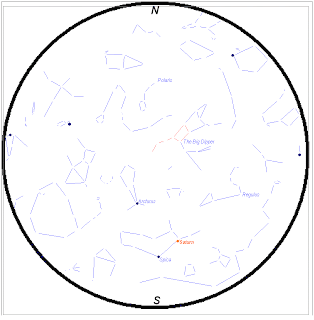.....It is hard to start off a column with an apology for two thousand years of common use (so I waited until the second paragraph! woo hoo!), but there is a habit that started with a Greek astronomer about 2300 years ago. This astronomer, Hipparchos, divided the stars in six categories with the brightest stars as "stars of the first rank" and the dimmest stars as "stars of the sixth rank". This seems to make sense until we track this this forward into the nineteenth century, and people are able to take photographs of stars and make absolute measurements of the amount of light coming from a particular star, as opposed to simply "brighter than that other star over there", when astronomers decided to keep the magnitude system.
.....This means that a star with a magnitude of 6.00 is the faintest star that can be seen with the naked eye (I normally use "unaided", but I want this blog to show up under Google searches for 'naked'; heck - naked naked naked) and a star with a magnitude of 1.00 is quite bright. The Sun has an apparent magnitude of -28. This can be hard to track. Still, at this level, we can still use the magnitude system in a reasonable way.
.....Consider this map below, which is the June 2011 sky as it might appear in a magazine such as Astronomy or Sky & Telescope, which shows stars down to fifth magnitude (going all the way to sixth magnitude would add about 1,600 tiny dots to the map; not a great deal of use is added.
.....(I chose to only include stars and asterisms that have come up in the blog. Since this blog is fairly young, that's not a lot.) Even if I had put all the names on the map, consider looking up at a sky like this:
.....If you are just starting out, this can be pretty darned intimidating, plus, unless you live someplace away from cities/car dealerships/McDonald's. I certainly can't walk out my back door and see fifth magnitude stars! We can speak of how many stars we can see by talking about a "limiting magnitude". A reasonably dark, moonless suburb, with no direct lines of sight to street lights, might have a sky with a limiting magnitude of fourth magnitude:
.....As you can see, even with a limiting magnitude of four, "holes" are appearing in the patterns. Move a little bit closer to town (or let the gibbous Moon rise), and we have a limiting magnitude of three:
.....That last one is about what the sky looks like from my back window on a good night. You'll notice lots of holes in constellation patterns; some entire constellations have vanished. At this point, the lack of stars (which might have seemed beneficial to a beginner who did not want to be overwhelmed) now works against us. This is why I started with the Big Dipper and a few bright stars. After all, toss in some thin clouds and we go to second magnitude. (Notice that when we are looking at this map there are a few sets of bright stars. The three bright stars rising in the east we will come back to, in time.)
.....And on a very bad night, if all that we can see are stars of first magnitude or brighter, the sky is fairly empty.
.....Drat. I just noticed that I did not add Saturn to the empty star maps.











:) Entertaining and informative, as usual, Sirrah!
ReplyDelete